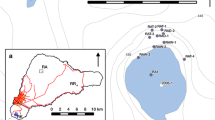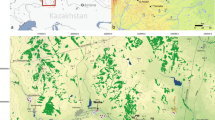Abstract
A 20-m sediment core from Rano Kau, Easter Island provides plant microfossil, arthropod fossil and high-resolution 14C sampling evidence for late Quaternary environments, ant (Formicidae) distributions and human activity. The record commences prior to or during the LGM, providing the two oldest dates for Rano Kau thus far, 20,340 ± 160 and 34,260 ± 440 BP. The vegetation at the time was mostly Arecaceae (palm)-dominated grassland-woodland, suggesting cooler/drier conditions than present. Near the start of the Holocene c. 12,500 cal BP, climate alleviation is indicated by Asteraceae shrubland increasing at the expense of grassland. There is an early to mid-Holocene sediment hiatus. The record recommences c. 3,500 cal BP, with in-washed clayey soils bearing charcoal and phytoliths of Polynesian-introduced Musa (banana) and mixed with wetland detritus, reflecting slumping as a result of forest clearance and gardening. Dates of material of other plants from the clay/detritus layers containing the Musa phytoliths are older than expected, within the range 3,680–2,750 cal BP, well before settlement of Eastern Polynesia. This could reflect horticultural material settling in an older part of the sediment column or age increase by reservoir effects. A long section of overlying unconsolidated detritus provides a progressively younger upward sequence from 2,840–2,870 to 930–810 cal BP, but dates are variable after 1,290–1,180 cal BP, where charcoal, disturbance-related pollen and older than expected ant exoskeletons demonstrate the inclusion of pre-aged material from the floating vegetation mat or upslope erosion in the sediment column. Arecaceae pollen declines sharply after 930–810 cal BP. Arthropod analysis reveals two new weevil species for Easter Island, and two ant taxa, Tetramorium bicarinatum and Pheidole sp., the latter of which is also new for the island. Three of the four age determinations on ant remains suggest that ants were present prior to c. 2,500 cal BP, and probably associated with the period following the resumption of sediment accumulation c. 3,500 cal BP. Unless the apparent ant 14C ages have been increased by reservoir effects, these results question the long-accepted assumption that all Eastern Polynesia’s ant species have been introduced.






Similar content being viewed by others
References
Azizi G, Flenley JR (2008) The last glacial maximum climatic conditions on Easter Island. Quatern Int 184:166–176
Baisden WT, Prior C, Chambers D, Canessa S, Phillips A, Bertand C, Zondervan A, Turnbull J, Bruhn F, Kaiser J (2012) Rafter radiocarbon sample preparation and data flow: Accommodating enhanced throughput and precision. Nuclear Instruments and Methods in Physics Research Section B: Beam Interactions with Materials and Atoms. doi:10.1016/j.nimb.2012.07.014
Balke M, Ribera I (2004) Jumping across Wallace’s line: Allodessus Guignot and Limbodessus Guignot revisited (Coleoptera: Dytiscidae, Bidessini) based on molecular-phylogenetic and morphological data. Aust J Entomol 43:114–128
Beavan-Athfield NR, McFadgen BG, Sparks RJ (2001) Environmental influences on dietary carbon and 14C ages in modern rats and other species. Radiocarbon 43:7–14
Bennike O (2000) Palaeoecological studies of Holocene lake sediments from west Greenland. Palaeogeogr Palaeocl 155:285–304
Blaauw M, Christen JA (2011) Flexible paleoclimate age-depth models using an autoregressive gamma process. Bayesian Analysis 6:457–474
Brown FBH (1935) Flora of southeastern Polynesia. III. Dicotyledons. Bernice P. Bishop Museum Bulletin 130, Bishop Museum Press, Honolulu
Butler K, Flenley J (2001) Further pollen evidence from Easter Island. In: Stephenson CM, Lee G, Morrin FJ (eds) Pacific 2000. Proceedings of the Fifth International Conference on Easter Island and the Pacific. Bearsville Press, Los Osos, pp 79–86
Butler KR, Flenley JR (2010) The Rano Kau 2 pollen diagram: palaeoecology revealed. Rapa Nui J 24:5–10
Butler K, Prior CA, Flenley JR (2004) Anomalous radiocarbon dates from Easter Island. Radiocarbon 46:395–405
Cañellas-Boltà N, Rull V, Sáez A, Margalef O, Giralt S, Pueyo JJ, Birks HH, Birks HJB, Pla-Rabes S (2012) Macrofossils in Raraku Lake (Easter Island) integrated with sedimentary and geochemical records: towards a palaeoecological synthesis for the last 34,000 years. Quaternary Sci Rev 34:113–126
Diamond JM (2005) Collapse: How societies choose to fail or succeed. Viking Press, New York
Dumont HJ, Cocquyt C, Fontugne M, Arnold M, Reyss J-L, Bloemendal J, Oldfield F, Steenbergen CLM, Korthals HJ, Zeeb BA (1998) The end of moai quarrying and its effect on Lake Rano Raraku, Easter Island. J Paleolimnol 20:409–422
Ferdon EN (1961a) A summary of the excavated record of Easter Island prehistory. In: Heyerdahl T, Ferdon E (eds) Reports of the Norwegian Archaeological Expedition to Easter Island and the East Pacific, vol 1. Allen and Unwin, London, pp 527–534
Ferdon EN (1961b) Stone houses in the terraces of Site E-21. In: Heyerdahl T, Ferdon E (eds) Reports of the Norwegian Archaeological Expedition to Easter Island and the East Pacific, vol 1. Allen and Unwin, London, pp 313–321
Ferdon EN (1961c) The ceremonial site of Orongo. In: Heyerdahl T, Ferdon E (eds) Reports of the Norwegian Archaeological Expedition to Easter Island and the East Pacific, vol 1. Allen and Unwin, London, pp 221–255
Fisher BL (2009) Ants. In: Gillespie RG, Clague DA (eds) Encyclopaedia of islands. University of California Press, pp 35–41
Flenley JR, King ASM, Teller JT, Prentice ME, Jackson J, Chew C (1991) The late quaternary vegetational and climatic history of Easter Island. J Quaternary Sci 6:85–115
Good R (1953) The geography of flowering plants, 2nd edn. Longman, London
Gonzalez-Ferran O, Mazzuoli R, Lahsen A (2004) Geología del complejo volcánico Isla de Pascua, Rapa Nui, Chile, V Región Valparaiso. Carta Geológica- Volcánica Isla de Pascua. Centro de Estudios Volcanologicos, Santiago
Gossen C (2007) Report: the mystery lies in the Scirpus. Rapa Nui J 21:105–110
Green R (2000) Origins for the Rapanui of Easter Island before European contact: solutions from holistic anthropology to an issue no longer much of a mystery. Rapa Nui J 14:71–76
Green A, Sánchez MI (2006) Passive internal dispersal of insect larvae by migratory birds. Biology Lett 2:55–57
Hernández A (2011) Internal dispersal of seed-inhabiting insects by vertebrate frugivores: a review and prospects. Integr Zool 6:213–221
Horrocks M (2005) A combined procedure for recovering phytoliths and starch residues from soils, sedimentary deposits and similar materials. J Archaeol Sci 32:1169–1175
Horrocks M, Nieuwoudt MK, Baisden WT, Flenley J, Feek D, González Nualart L, Haoa Cardinali S, Edmunds Gorman T (2012a) Microfossils of Polynesian cultigens in lake sediment cores from Rano Kau, Easter Island. J Paleolimnol 47:105–284
Horrocks M, Baisden WT, Flenley J, Feek D, González Nualart L, Haoa Cardinali S, Edmunds Gorman T (2012b) Fossil plant remains at Rano Raraku, Easter Island’s statue quarry: Evidence for past elevated lake level and ancient Polynesian agriculture. J Paleolimnol 48:767–783
Hunt TL, Lipo CP (2006) Late colonization of Easter Island. Science 311:1603–1606
Kirch PV, Conte E, Sharp W, Nickelsen C (2010) The Onemea Site (Taravai Island, Mangareva) and the human colonization of Southeastern Polynesia. Archaeol Oceania 45:66–79
Mann D, Edwards J, Chase J, Beck W, Reanier R, Mass M, Finney B, Loret J (2008) Drought, vegetation change, and human history on Rapa Nui (Isla de Pascua, Easter Island). Quaternary Res 69:16–28
Martinsson-Wallin H, Crockford SJ (2001) Early settlement of Rapa Nui (Easter Island). Asian Perspect 40:244–278
McCormac FG, Hogg AG, Blackwell PG, Buck CE, Higham TFG, Reimer PJ (2004) ShCal04 Southern Hemisphere calibration, 0–11.0 cal kyr BP. Radiocarbon 46:1087–1092
McCoy PC (1976) Easter Island settlement patterns in the Late Prehistoric and Protohistoric periods. Bulletin 5. Easter Island Committee, International Fund for Monuments, Inc., New York
Mindzie CM, Doutrelepont H, Vrydaghs L, Swennen L, Swennen RJ, Beeckman H, de Langhe E, de Maret P (2001) First archaeological evidence of banana cultivation in central Africa during the third millennium before present. Veg Hist Archaeobot 10:1–6
Moore PD, Webb JA, Collinson ME (1991) Pollen analysis, 2nd edn. Blackwell Scientific, London
Morrison LW (1997) Polynesian ant (Hymenoptera: Formicidae) species richness and distribution: a regional survey. Acta Oecologica 18:685–695
Olsson IU (1986) A study of errors in 14C dates of peat and sediment. Radiocarbon 28:429–435
Ordish RG (1966) A systematic revision of the New Zealand water beetles (Coleoptera: Dytiscidae). Records of the Dominion Museum 5:217–264
Peteet D, Beck W, Ortiz J, O’Connell S, Kurdyla D, Mann D (2003) Rapid vegetational and sediment change from Rano Aroi Crater, Easter Island. In: Loret J, Tanacredi JT (eds) Easter Island: Scientific exploration into the World’s environmental problems in microcosm. Kluwer, New York, pp 81–92
Reimer PJ et al (2004) IntCal04 Terrestrial Radiocarbon Age Calibration, 0–26 cal kyr BP. Radiocarbon 46:1029–1059
Sáez A, Valero-Garcés BL, Giralt S, Moreno A, Bao R, Pueyo JJ, Hernández A, Casas D (2009) Glacial to Holocene climate changes in the SE Pacific. The Raraku Lake sedimentary record (Easter Island, 27°S). Quaternary Sci Rev 28:2743–2759
Santos GM, Southon JR, Griffin S, Beaupre SR, Druffel ERM (2007) Ultra small-mass AMS 14C sample preparation and analyses at KCCAMS/UCI Facility. Nucl Inst Methods Phys Res Sect B: Beam Inter Mater Atoms 259:293–302
Steadman D (1995) Prehistoric extinctions of Pacific Island birds: biodiversity meets zooarchaeology. Science 267:1123–1131
van Steenis CGGJ, van Balgooy MMJ 1966. Pacific plant areas. Vol. 2. Blumea 5 (suppl.):1–312
Van’t Veer R, Hooghiemstra H (2000) Montane forest evolution during the last 650,000 years in Colombia: a multivariate approach based on pollen record Funza-I. J Quaternary Sci 15:329–346
Van’t Veer R, Islebe G, Hooghiemstra H (2000) Climatic change during the Younger Dryas chron in northern South America: a test of the evidence. Quaternary Sci Rev 19:1821–1835
Wheeler WM (1922) Formicidae from Easter Island and Juan Fernandez. In: Skottsberg C (ed) The natural history of Juan Fernandez and Easter Island. Almqvist & Wiksells, Uppsala, pp 317–319
Wilmshurst JM, Eden DE, Froggatt PC (1999) Late Holocene forest disturbance in Gisborne, New Zealand: a comparison of terrestrial and marine pollen records. New Zeal J Bot 37:523–540
Wilmshurst JM, Hunt TL, Lipo CP, Anderson AJ (2011) High-precision radiocarbon dating shows recent and rapid initial human colonization of East Polynesia. P Natl Acad Sci 108:1815–1820
Wilson EO (1973) The ants of Easter Island and Juan Fernandez. Pac Insects 15:285–287
Zimmermann A (1924) 30. Coleoptera-Dytiscidae von Juan Fernandez und der Osterinsel. In: Skottsberg C (ed) The natural history of Juan Fernandez and the Easter Island. Almqvist & Wiksells, Uppsala, pp 299–304
Acknowledgments
This work was supported by the Marsden Fund of the Royal Society of New Zealand. We thank the Corporación Nacional Forestal for site access and Zoro Babel for fieldwork assistance. We thank Guillermo Kuschel, Darren Ward and Ignacio Ribera for assistance with arthropod identification, Andy Tulloch and John Dando for loaning magnetic susceptibility equipment, and Juliet Hawkins for Fig. 6. Martin Blaauw provided useful instructions for the use of the Bacon model. We also thank staff at the Rafter Radiocarbon Lab, especially those involved in developing the capability to date samples <50 μg C.
Author information
Authors and Affiliations
Corresponding author
Electronic supplementary material
Below is the link to the electronic supplementary material.
10933_2013_9735_MOESM1_ESM.tif
S1 Musa phytoliths; mounted in Caedex; transmitted light; 600x; scale bar, for all: 20 μm. a,b Fossil Musa sp. leaf phytoliths from Rano Kau core, at 18.0 and 15.9 m depths, respectively. c,d Musa x paradisiaca leaf phytoliths from modern reference sample, showing typical rectangular/squarish base with side protuberances and cone (TIFF 888 kb)
10933_2013_9735_MOESM2_ESM.tif
S2 Fossil ant heads from Rano Kau core; diameters measured from outer edge of eyes. a Pheidole sp., 0.55 mm, from 11 m depth. b Tetramorium bicarinatum, 1.02 mm, from 11.0-11.05 m depth (TIFF 434 kb)
Rights and permissions
About this article
Cite this article
Horrocks, M., Marra, M., Baisden, W.T. et al. Pollen, phytoliths, arthropods and high-resolution 14C sampling from Rano Kau, Easter Island: evidence for late Quaternary environments, ant (Formicidae) distributions and human activity. J Paleolimnol 50, 417–432 (2013). https://doi.org/10.1007/s10933-013-9735-5
Received:
Accepted:
Published:
Issue Date:
DOI: https://doi.org/10.1007/s10933-013-9735-5




